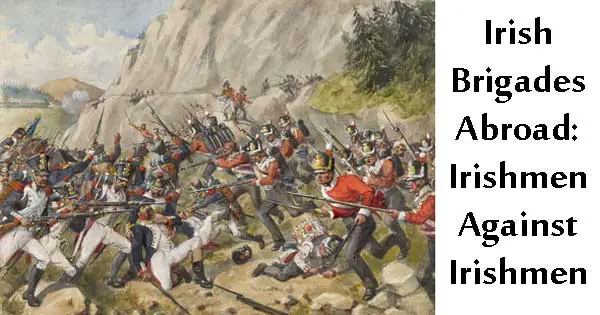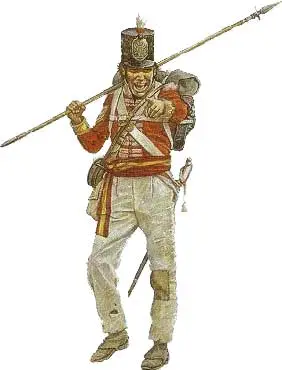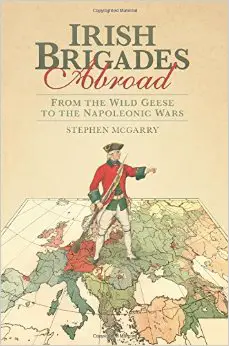For centuries, regiments of Irish soldiers were incorporated into the armies of the great European powers. Tragically, it meant that Irishmen often had to fight each other on foreign soil for a cause that was not their own. Historian Stephen McGarry, author of Irish Brigades Abroad, tells their story.
The story of the ‘Wild Geese’ is a much neglected aspect of Irish history, this is surprising as the tradition of Irishmen soldiering overseas is a long and proud one and extends back to 1587 when Irish units were formed in the Spanish army. The Jacobite War (1689-91) was fought between supporters of the deposed Catholic King James and supporters of the Protestant King William and was the catalyst for Irish migration to Continental Europe. Limerick’s capitulation marked the end of the war when the 14,000 Irish army withdrew to France in what became known romantically as the ‘The Flight of the Wild Geese’. The Irish army were then formed into units called ”Irish brigades” in France and Spain and wore red uniforms – the colours of the deposed Stuart kings – as they hoped that a Catholic restoration would finally return their lands and rights back home. There were also Irish units in Austria, Bavaria and in Imperial Russia and beyond.

Irishmen serving all over Europe resulted in many facing their countrymen in battle. During the War of the Spanish Succession in 1702, two Irish regiments in the French Army defended the Italian town of Cremona when it was attacked by their fellow countrymen in the Austrian service.
While Field-Marshall Browne, together with other Irish officers in the Austrian service attacked the Spanish headquarters at Velletri outside Spain, unaware perhaps that it was being defended by two battalions of the Spanish Irish Brigade, resulting in over 400 Irish casualties, including the death of the Regiment of Irlanda’s colonel, Daniel MacDonnell.
Irish soldiers ‘fighting every cause but their own’
While it was during the murderous Battle of Malplaquet (1709) in the Low Countries when an Irish detachment in the British Army led by Captain Robert Parker from Co Kilkenny ventured deep into the woods where the French had entrenched themselves and engaged an Irish regiment in the French army, commanded by Colonel Michael Rothe also from Kilkenny. A fierce musket duel followed, both red-coated regiments – one in the British, the other in the French service – apparently unaware that they were fighting their fellow Irishmen until after the fire-fight ended.

‘We advanced cautiously up to the ground which they had quitted,’ Parker wrote with astonishment, ‘and found several of them killed and wounded; among the latter was one Lieutenant O’Sullivan, who told us the battalion we had engaged was the Royal Regiment of Ireland.’
The Irish Brigade of France was disbanded during the French Revolution. But several years later in 1803 Napoleon formed a new Irish light infantry unit to spearhead an anticipated invasion of Ireland. This unit was called Napoleon’s Irish Legion and comprised many United Irishmen who had fled to France following the 1798 and 1803 Rebellions. However, plans for an invasion of Ireland were firmly put on hold due to the defeat of the French and Spanish fleet at Trafalgar in 1805 and as a result the Irish Legion was later ordered to the war in Spain.
It was inevitable that they too would clash with their countrymen, as for every Irishman who wore a French uniform in the Napoleonic Wars there were ten who wore a British one. Irishmen fighting on opposite sides has always been a cause of bitterness and this was especially evidenced during the Peninsular War. An Irish officer, called O’Flyn was captured after leading a French cavalry charge against a British force in Salamanca, in north-western Spain.
Private Fitzpatrick serving with a British dragoon regiment pistoled the Irish officer on the spot, rather than take him prisoner, as he had been so enraged that a fellow Irishmen had been fighting for the French, recorded Fitzpatrick’s commanding officer in his diary, ‘that he could not permit him to escape alive.’
The Battle of Busaco (1810) was a key engagement when Field-Marshal Wellesley, the Duke of Wellington’s Anglo-Portuguese army took up a strong defensive position high up in the Portuguese mountains to halt the advancing French columns who were doggedly pursuing him. A French division, including several light companies of the 2nd and 3rd battalions of Napoleon’s Irish Legion, climbed the ridge up to the British position, before several companies of the Connaught Rangers, an Irish regiment in the British Army, led a ferocious bayonet charge and sent them reeling back down the mountain.
Wellington never saw a more gallant charge
Wellington was so impressed by their bravery and derring-do that he declared that he ‘never saw a more gallant charge.’ One can imagine the scene of the Connaught’s and the Irish Legion both playing the same regimental Irish air of ‘St Patrick’s Day in the Morning’ to rally their men before the attack but from opposite sides!

At the auspicious occasion of the Battle of Waterloo, where it has been estimated that 8,500 Irishmen fought on the British side, things fared little different. Two French units present there were three battalions of the 92e numbering 1322 men and two of the 88e Régiments d’Infanterie of 1068 men formerly Walsh’s and Berwick’s regiments of the ancien regime Irish Brigade of France.
It is difficult to establish the size of the Irish contingent of these former regiments at Waterloo, but according to the Memoirs of Miles Byrne who documented his time in the Irish Legion, ‘many of the officers of those regiments [formerly Walsh’s and Berwick’s] were Irishmen, some born in France, and others in Ireland.’
The 92e, formerly Berwick’s, was heavily engaged in the actions at the strategic Hougoumont Farm where the fighting was close and vicious, as according to Wellington ‘success in the battle depended on [the British] closing the gates’ there. The 92e were wiped out here as the dead were piled up two and three deep in and around the farm and orchard and the 92e suffered such high losses that it was rendered a spent force.
The story of the ‘Wild Geese’ is a picture of the old-fashioned virtues of honour and chivalry, of adventure and sacrifice in the name of a greater cause but sadly it is also one of Irishmen fighting Irishmen. The words of the poet Emily Lawless also rang true when she wrote they were ‘fighters in every clime, every cause but their own.’
 Stephen McGarry lives in Dublin, Ireland and is the author of Irish Brigades Abroad (2013) which was selected as an Irish Times Book of the Year 2014.
Stephen McGarry lives in Dublin, Ireland and is the author of Irish Brigades Abroad (2013) which was selected as an Irish Times Book of the Year 2014.
He has spent many years in Belgium where he discovered its links to Irish history, particularly to the Irish Brigades and has written widely on the Irish military diaspora in the period and has been researching the subject over many years in Ireland and across Europe.
history.html